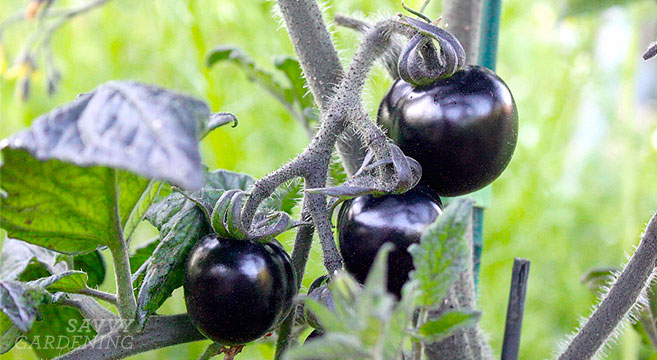This post may contain affiliate links. If you make a purchase through links on our site, we may earn a commission.
For the past few years, I’ve been hearing more and more about grafted tomatoes. Last year was the first time they were offered at garden centres in my region, but I took a pass. It seemed like there was a lot of hype surrounding them, and my penny-pinching self didn’t want to pay $12.99 for a single tomato seedling. This year, grafted tomatoes are back, with even more glitzy advertising, and so I threw in the trowel and added an ‘Indigo Rose’ grafted tomato to my garden.
Grafted tomatoes:
Here are the claims made by companies that sell grafted tomatoes:
-
Bigger, stronger, and more vigourous plants!
-
Excellent resistance to soilborne diseases (like Bacterial Wilt, Fusarium Wilt, and Verticillium Wilt)!
-
Larger yield and longer harvest season!
But, what’s the truth? I turned to Andrew Meffert, tomato expert and the senior trial Technician at Johnny’s Selected Seeds in Winslow, Maine, to set the record straight on grafted tomatoes. Johnny’s has been carrying grafted tomatoes for professional growers for almost a decade and Andrew has been running the trials on these plants for the past six years. “I’m basically a talent scout for plants,” he says. “It’s my job to set up and run the trials for the crops I’m involved with and to make sure they are taken care of and evaluated for performance.”
Wait, let’s back up for a second. What exactly is a grafted tomato? The concept is actually quite simple. It is the result of fusing two different tomato varieties – the top variety is the one that will bear the fruit, and the bottom variety is the rootstock, chosen for its exceptional vigour and resistance to soilborne diseases.

So, I asked Andrew if grafted tomatoes are worthwhile for home gardeners. His response? YES! “There are two big benefits to grafted tomatoes: 1) Increased resistance to soilborne diseases and 2) The rootstocks are larger and much more vigorous than on non-grafted tomatoes and this makes the plant grow faster, with a larger leaf area, and a 30- to 50 per cent greater overall yield.” Um, wow!
Andrew also points out that if you live in a short-season climate or have a garden that has less-than-ideal soil conditions, opting for grafted tomatoes will make up for some of these shortcomings and increase yield. As well, grafting less productive, or more disease-prone varieties, like heirlooms or my ‘Indigo Rose’ (featured in the top photo), onto a robust and disease-resistant rootstock will result in increased vigour and fruit production.

Andrew also owns a farm, selling his crops in CSAs and at farmers’ markets. Does he grow grafted tomatoes? “I personally graft all the tomatoes on my farm,” he says. “It’s a painstaking and tedious process, but those gardeners who like hands-on projects may enjoy perfecting their tomato grafting techniques.” For more information, Johnny’s Selected Seeds has created an online step-by-step information sheet with plenty of glossy photos of the process.
If you’d rather not attempt grafting yourself, many garden centres now offer a selection of grafted tomatoes, including heirloom types like ‘Brandywine’, ‘Black Krim’ and ‘Cherokee Purple’. Plus, cucumbers, peppers, eggplants and melons are also joining the grafting craze, so don’t be surprised to find these upgraded edibles at your local greenhouse, if not now, in the very near future.
Have you grown grafted tomatoes?



YES THESE ARE EXPENSIVE….EVEN THE SEEDS FOR ROOT STOCK
——————-
CAN I GROW OUT THE ROOT STOCK SEEDS….LET THE PLANTS MATURE….AND SAVE MY OWN SEEDS FOR THE NEXT SEASON??
—————
THIS WOULD BE VERY ECONOMICAL!!!
what do you think
As long as the root stock varieties are open pollinated or heirloom types, you can do so. If they are hybrids, I wouldn’t bother saving seed as they will prob not come true to type. Good question!
I was thinking the same thing, but realized i would probably have a million more seeds than necessary for creating my own grafted tomatoes. (and I’m pretty sure the trick is starting everything indoors/greenhouse VERY early…)
But then i remembered a short article i read about saving roots from a certain type of flowering plant (flowering tobacco?) to reliably recreate — clone — the plant next season. I don’t know if saving roots from a tomato would work the same way, but rooting some of the top growth might. The article about the flower roots said to just cut 4″ lengths, paying attention to hich way was “up”, then wrapping in damp paper towels/plastic wrap and storing over winter in fridge. For the tomato, if you were able to get some top growth and root a 6″ “branch” in water, then plant in sterile soil until early spring, growing indoors, you would have a rootstock you could use as is, or start additional ones that would be smaller stemmed to match girth for proper grafting. If you try this, please post back, with pictures!
I Googled grafted tomato plants because I was surprised last spring to discover that one of the tomato starts I had purchased (a cherry tomato variety) was forming 2 different sized fruit. One of the bottom stems had medium sized fruit, while the remainder of the plant produced cherry sized tomatoes. This growth pattern has continued throughout the season. When I look closely at the base to see if possibly there are 2 side by side main stems, I see no evidence of this. Additionally, I have run my fingers up and down the main stem to confirm that there is just the one.
I’m sure there must be others who have had this experience.